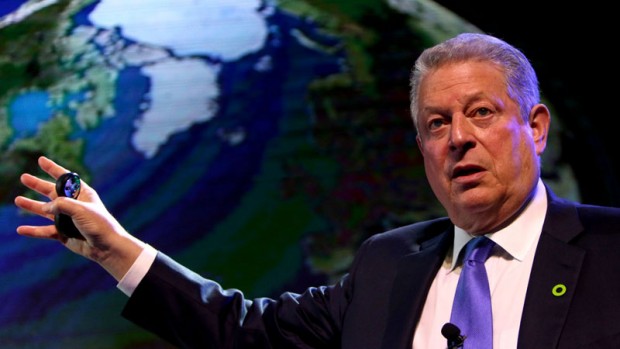Al Gore told: Climate-change battered PH still resorting to coal

BOMB DROPPED Former US Vice President Al Gore, an environment advocate, likens the effects of climate change to the
Hiroshima and Nagasaki bombings in his speech before delegates of the Climate Reality Leadership Corps Training. RICHARD A. REYES
Former US vice president Al Gore on Wednesday heard more about the environmental issues faced by the Filipino people, including plans to construct more coal-fired plants.
Ateneo School of Government dean Antonio “Tony” La Viña, when asked by Gore during a panel on the challenges faced by the Philippines, said “the road blocks are real.”
La Viña said the Philippines cannot afford to put up more facilities that produce greenhouse gases, if it is to follow the country’s submitted Intended Nationally Determined Contributions (INDCs).
“Anything we put up we have to take down. That’s how challenging it is,” he said in front of more than 600 people undergoing the 3-day Climate Reality Leadership Corps training in Sofitel, Manila.
“We have quite a lot of coal-fired power plants already being built now,” said La Viña, who was the spokesperson of the Philippine delegation during the last climate change negotiations in Paris.
Article continues after this advertisementHe said the first “clear policy” the government “needs to resolve is a cap on coal.”
Article continues after this advertisementLa Viña’s statement was met with applause.
However, the Ateneo dean explained that President Benigno Aquino III has been working to address climate change.
“There is a promise of support,” he said, adding that the country will also need support from the international community.
The Philippines, which has become the poster boy of countries vulnerable to climate change, played a critical role during the 21st Conference of Parties in Paris last December.
The delegation pushed for progressive provisions in the agreement, which provides for the capping of global temperature rise “ to well below 2 °C above pre-industrial levels and to pursue efforts to limit the temperature increase to 1.5 °C above pre-industrial levels, recognizing that this would significantly reduce the risks and impacts of climate change.”
READ: PH ‘conditional’ commitment: Reduce carbon emissions by 70% in 2030
Secretary Emmanuel de Guzman of the Climate Change Commission (CCC) said during the same panel event that the government is revisiting its INDC and “will strengthen the basis of the implementation.”
He said the agency is “looking deeply into each and every” pledge mentioned in the INDC.
“Right now the national agencies concerned are developing their respective national roadmaps and examining existing policies to be able to really deliver the target they will set per sector,” he said.
However, because of its energy needs, the country is set to have 25 new coal-fired power plants in the next decade.
READ: Why is PH building 25 more coal-powered plants?
Senator Loren Legarda, who gave a speech during the first day of the training, earlier said that the Philippines seems to be “taking the opposite track” because of the decision to have more coal power plants instead of clean energy.
She said the government was resorting to the “easy and affordable” solution of constructing coal-fired power plants to fill the country’s projected need of 13,167 megawatts of energy by 2030.
Legarda said at least 25 of these power plants have been granted environmental compliance certificates and are either operational or under construction.
Aquino has in the past argued that coal-fired power plants are necessary because they supply base load power. They are able to run and produce energy throughout the year unlike solar and hydroelectric facilities, which depend on weather conditions.
READ: Aquino not keen on coal-free Palawan
La Viña also said that to cap coal in the Philippines, there should be a mandatory energy mix or plan to have a certain number or share of renewable and non-renewable energy sources.
However, he said that the country cannot lose electricity as it pursues clean energy.
He said having brownouts and blackouts because of the preference for renewable energy will only result in the loss of public support.
Gore, during one of his presentations, said he didn’t want to meddle in the political affairs of the Philippines but said that something must be done to increase solar facilities and reduce dirty sources of energy.
Gore was in the country to train “climate leaders” who are responsible for discussing the issue of climate change and suggesting solutions to ease its effects.